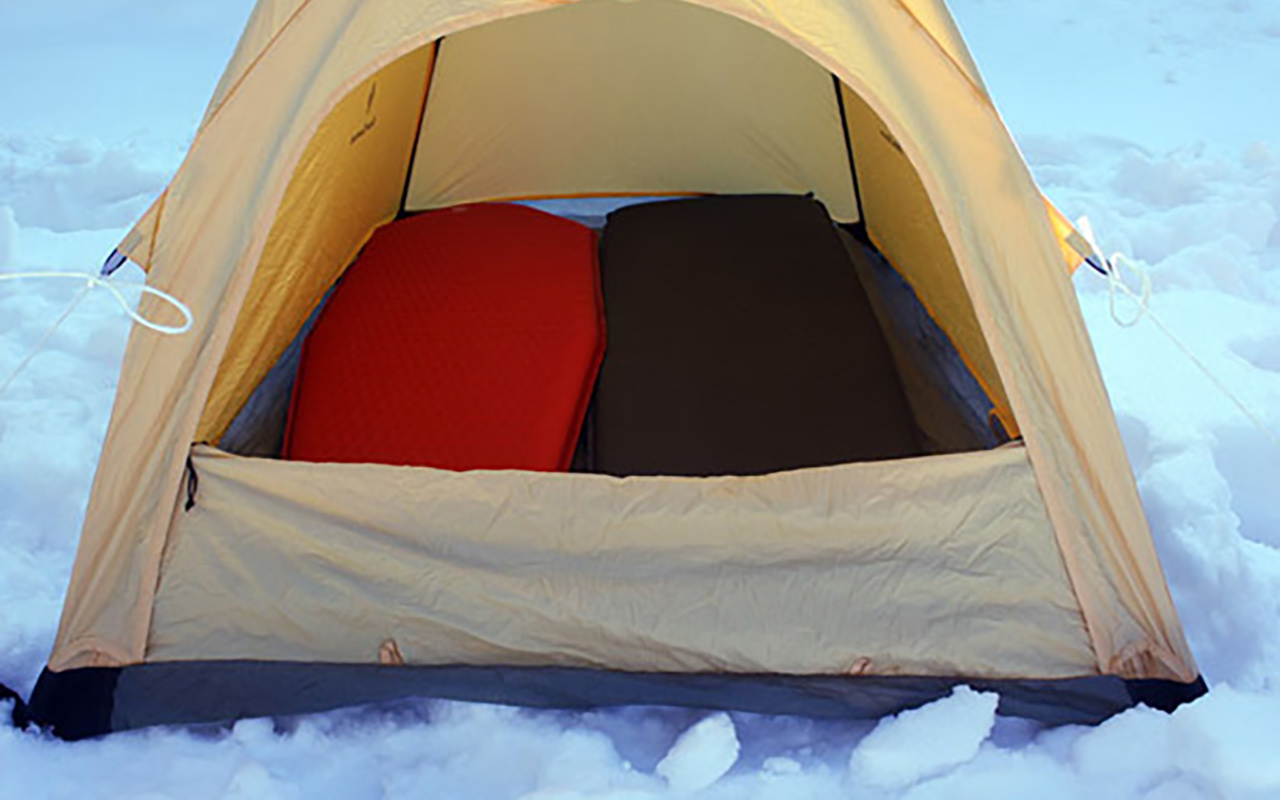Snow Camping – Sleeping Pad Comparison

We're here in Flagstaff, AZ, en route to Colorado for our annual family ski vacation, and I've got my tent set up in my parents' yard. No—it's not that my folks are driving me crazy. With overnight lows an invigorating 8° and two to three feet of snow all around, I thought now would be an excellent time to set up a snow camp and run a few tests.
Atop today's agenda is a more thorough comparison of two winter self-inflating sleeping pads, the Thermarest Prolite Plus and Big Agnes' Two Track 2" Mummy. While I've already got reviews of these online, I just didn't feel I had done enough testing to answer a few key questions I had.
Both of these are four-season pads, specifically intended for snow camping. Of the two, the Thermarest is considerably lighter (24 versus 36 ounces). However, the rated insulation value of the Big Agnes is considerably higher (6.5 versus 3.2 r-values). Thus, the vexing question: which pad is the better choice for winter camping: lighter or warmer?
Well first, let's answer how much warmer the Big Agnes is. For today's experiment, I put on a t-shirt and sweats and lay directly on both pads inside my tent on snow. To keep from going shiver-crazy, I draped a sleeping bag on top of myself, but there was basically no insulation between me and the snow other than the pads. How did they do?
As you might expect, the Two Track's much higher r-value proved significant. It was plainly obvious that I was lying down on snow on the Thermarest. I could easily feel the cold seeping through the Prolite 4, and this was especially true over pressure points like my heels and my butt. In comparison, I could almost forget I was on snow on the Two Track.
I say almost because the same pressure-point issue remained noticeable, though not as dramatic. Wherever my weight was evenly spread, the Two Track Pad felt wonderfully neutral. Comfortable enough, in fact, for me to take a little nap. But I still could feel cold at my butt and my heels. If I turned on my side, the same was true for my hip.
This answers a question I've been puzzling over for a while: if the pad's insulation value is so high, why does Big Agnes nonetheless recommend doubling the Two Track with a closed-cell foam pad on snow? The answer now seems obvious. Inflatable pads, regardless of r-value, are vulnerable to getting squished beneath pressure points like your hips, heels, head, and butt.
By adding a small custom-cut foam pad beneath these areas, as needed, you can greatly improve the pad's overall comfort on snow (your butt, after all, is part of your core—you don't want to be losing heat through such large muscles).
So, some opinions: if I was forced to sleep on snow without any supplemental closed-cell foam padding, I would definitely want the Two Track in cold weather. For on-snow camping in relatively mild temperatures, the Prolite 4 will do, but you will notice heat loss through the pad unless you supplement with foam.
The Two Track alone will probably provide a pretty darn comfortable night's rest in most conditions. Add a thin square of foam padding (or folded clothing) where needed, and you'll be in the lap of luxury on snow. As for the extra weight and bulk, it may not be as much of a liability as you think. Simply getting a good night's sleep is absolutely worth a few more ounces. You'll earn a return on those ounces in terms of extra energy and reduced food demand. You'll also be able to sleep more comfortably in less clothing and in a lighter sleeping bag—so you'll at least partially be able to make up some of that extra weight.
We may be tempted to choose the Prolite 4 in situations where weight concerns override all else. That said, it's entirely possible this is a penny-wise pound-foolish choice. Is shivering all night really worth twelve ounces? Similarly, the Prolite's weight and bulk advantages vanish if we're required to add a short Ridgerest pad for extra insulation.
One more thing: for goodness sake always take a repair kit if you're using an inflatable pad in a critical winter situation. One tear, and you've otherwise just lost all your sleep system insulation!
— February 19, 2009
Andy Lewicky is the author and creator of SierraDescents
Robert K February 20, 2009 at 10:41 am
'Think you may have a typo in the listed weights. You say, "24 versus 26 ounces" in the opening, but mention a twelve ounce difference at the end. 'Betting you meant 36, not 26.
Matt February 23, 2009 at 12:16 pm
You should add the Exped Downmat 7 to the mix for winter camping on snow. 5.9 r value and only 32 oz in the full length size or 23.5 oz in the 3/4 length and packs down to about the size of a nalgene. I'm very happy with mine.